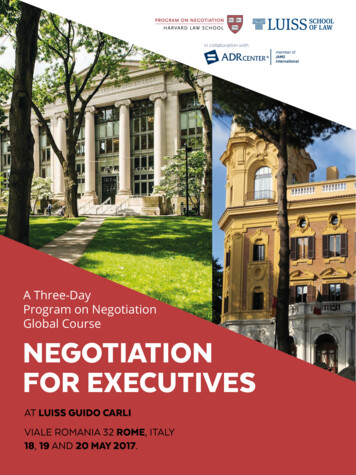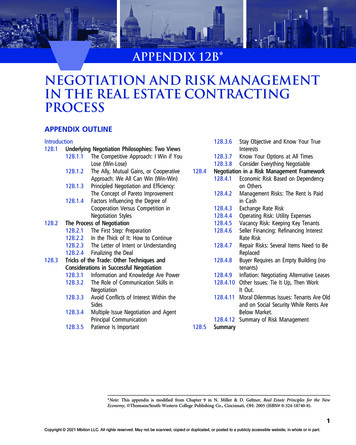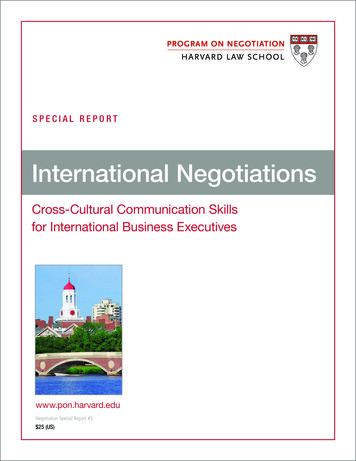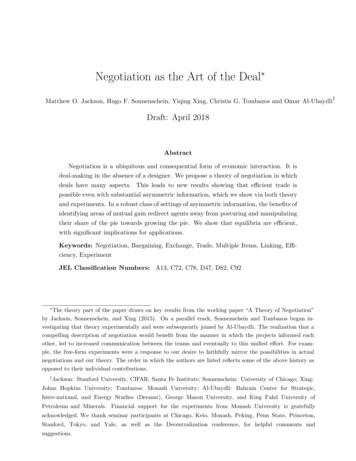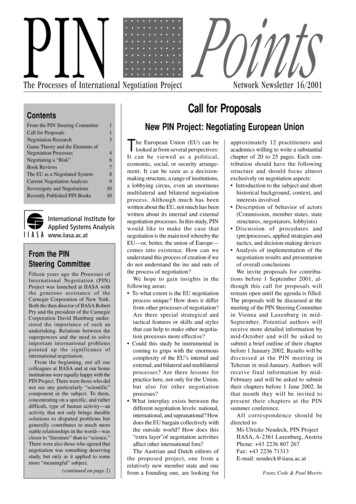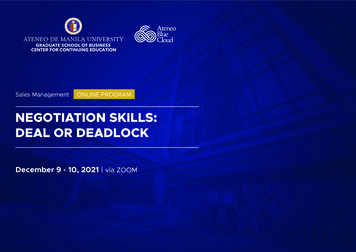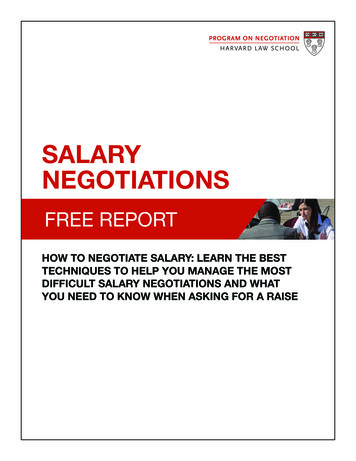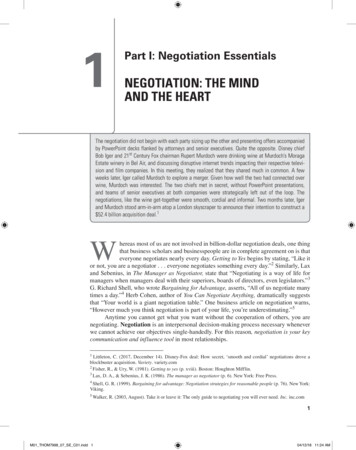
Transcription
1Part I: Negotiation EssentialsNEGOTIATION: THE MINDAND THE HEARTThe negotiation did not begin with each party sizing up the other and presenting offers accompaniedby PowerPoint decks flanked by attorneys and senior executives. Quite the opposite. Disney chiefBob Iger and 21st Century Fox chairman Rupert Murdoch were drinking wine at Murdoch’s MoragaEstate winery in Bel Air, and discussing disruptive internet trends impacting their respective television and film companies. In this meeting, they realized that they shared much in common. A fewweeks later, Iger called Murdoch to explore a merger. Given how well the two had connected overwine, Murdoch was interested. The two chiefs met in secret, without PowerPoint presentations,and teams of senior executives at both companies were strategically left out of the loop. Thenegotiations, like the wine get-together were smooth, cordial and informal. Two months later, Igerand Murdoch stood arm-in-arm atop a London skyscraper to announce their intention to construct a 52.4 billion acquisition deal.1Whereas most of us are not involved in billion-dollar negotiation deals, one thingthat business scholars and businesspeople are in complete agreement on is thateveryone negotiates nearly every day. Getting to Yes begins by stating, “Like itor not, you are a negotiator . . . everyone negotiates something every day.”2 Similarly, Laxand Sebenius, in The Manager as Negotiator, state that “Negotiating is a way of life formanagers when managers deal with their superiors, boards of directors, even legislators.”3G. Richard Shell, who wrote Bargaining for Advantage, asserts, “All of us negotiate manytimes a day.”4 Herb Cohen, author of You Can Negotiate Anything, dramatically suggeststhat “Your world is a giant negotiation table.” One business article on negotiation warns,“However much you think negotiation is part of your life, you’re underestimating.”5Anytime you cannot get what you want without the cooperation of others, you arenegotiating. Negotiation is an interpersonal decision-making process necessary wheneverwe cannot achieve our objectives single-handedly. For this reason, negotiation is your keycommunication and influence tool in most relationships.1Littleton, C. (2017, December 14). Disney-Fox deal: How secret, ‘smooth and cordial’ negotiations drove ablockbuster acquisition. Variety. variety.com2Fisher, R., & Ury, W. (1981). Getting to yes (p. xviii). Boston: Houghton Mifflin.3Lax, D. A., & Sebenius, J. K. (1986). The manager as negotiator (p. 6). New York: Free Press.4Shell, G. R. (1999). Bargaining for advantage: Negotiation strategies for reasonable people (p. 76). New York:Viking.5Walker, R. (2003, August). Take it or leave it: The only guide to negotiating you will ever need. Inc. inc.com1M01 THOM7998 07 SE C01.indd 104/12/18 11:24 AM
2Part I Negotiation EssentialsNow, a depressing fact: over 80% of corporate executives and CEOs leave money on thetable. In this chapter, we explain why educated, smart, motivated people often do not realizetheir negotiating potential. The good news is that you can do something about it.The purpose of this book is to improve your ability to negotiate. We do this through anintegration of scientific studies on negotiation and real business cases. And in case you arewondering, it is not all common sense. Science drives the best practices covered in this book.We focus on business negotiations, but the principles in this book will no doubt help you in allaspects of your negotiating life.6THE MIND AND HEARTAcross the sections of this book, we focus on the mind of the negotiator as it involves thedevelopment of rational and thoughtful strategies for negotiation, designed to maximize economic value. We also focus on the heart of the negotiator because ultimately we care aboutrelationships and trust. The opening example clearly indicates that the trust developed betweenBob Iger and Rupert Murdoch laid the foundation for a successful negotiation deal.Relationships versus EconomicsIn virtually any negotiation, two things are at stake: economic value (i.e., money and scarceresources) and people (relationships and trust). This book focuses on how negotiators can beeffective in terms of maximizing both economic value and enhancing relationships at the bargaining table. We base our teachings and best practices on scientific research in the areas ofeconomics and psychology, reflecting the idea that both the bottom line and relationships areimportant for successful negotiation.7Many people believe they need to choose between getting what they want or being liked.These negotiators often believe that by “taking one for the team,” they can later maximize theireconomic gain.8 This strategy is not advisable because we negotiate in long-term relationshipswith people who have short-term memories. The relational sacrifice we make today may notbe remembered or reciprocated by the receiving party tomorrow. When people make economicsacrifices in hopes of securing or maintaining relationships, they are often disappointed. In thisbook, we focus on how negotiators can achieve their economic objectives and enhance theirlong-term relationships, without simply paying more or receiving less.Satisficing versus OptimizingIn this book, we distinguish between satisficing and optimizing. According to Nobel LaureateHerb Simon, satisficing is the opposite of optimizing.9 Satisficing refers to doing just enough toreach one’s minimum goals. When negotiators satisfice, they take shortcuts and do not maximizetheir potential gains. Conversely, when negotiators optimize, they capture all of the potentialgain in a situation.6Gentner, D., Loewenstein, J., & Thompson, L. (2003). Learning and transfer: A general role for analogical encoding.Journal of Educational Psychology, 95(2), 393–408.7Bazerman, M. H., Curhan, J. R., Moore, D. A., & Valley, K. L. (2000). Negotiation. Annual Review of Psychology, 51,279–314.8Thompson, L. L. (2017). Don’t take one for the team. Kellogg News and Events. kellogg.northwestern.edu/news articles9Simon, H. A. (1955). A behavioral model of rational choice. Quarterly Journal of Economics, 69, 99–118.M01 THOM7998 07 SE C01.indd 204/12/18 11:24 AM
Chapter 1 Negotiation: The Mind and the Heart3In negotiation it is important to optimize one’s strategies by setting high aspirations andattempting to achieve as much as possible. In contrast, when people satisfice, they settle forsomething less than they could otherwise have. Over the long run, satisficing (or the acceptanceof mediocrity) can be detrimental to individuals and companies, especially when a variety ofeffective negotiation strategies and skills can be effectively employed to dramatically increaseeconomic gains. We discuss these strategies in detail in the next three chapters.Short- versus Long-term RelationshipsAnother distinction people often struggle with concerns strategies they might use in shortversus long-term relationships. The intuition is that if a person believed the negotiation was asingle-shot situation, they might behave differently—perhaps more aggressively—than if theyanticipated interacting with the counterparty in the future. In the networked, virtual world, thisdistinction is nearly irrelevant because most of our interactions are recorded or known to others.Even if a negotiator does not actually meet a given counterparty again, by virtue of social media,a detailed account of their interaction would surely be visible for anyone to see. When the exCEO of Uber Travis Kalnick got into a heated argument with an Uber driver, he did not realizethat Fawzi Kamel had a dashboard recording of the infamous conversation, nor that the recording would be posted online.10 For these reasons, I encourage all of my students and executivesto assume that the details of their negotiation communication and behavior will be accessible foranyone who might be interested, and consequently, to act as though all negotiations have longterm implications.Intra- versus Inter-organizational NegotiationWould you imagine that there might be different strategies for negotiating with internal people(i.e., inside one’s own organization) versus external people (i.e., people not employed by one’sown organization)? At first blush, it would seem that internal negotiations might go moresmoothly and collaboratively than external negotiations. However, that is not always the case.Envy and internal competition may in fact loom larger when people negotiate internally versusexternally.11Low- versus High-Stakes NegotiationOn countless occasions, managers and executives in my classroom have commented thatthey are not concerned that they failed to reach a win-win outcome because the negotiation was “lowstakes.” When I then ask them how many “low stakes” negotiations they areinvolved in per week, they often say as few as 3 and as many as 15, with an average of about8 or 9. If we then extrapolate for just 1 year, this totals over 400 negotiations; across a spanof 5 years, that is 2,000 negotiations! Even if each negotiation was only 100, we are nowstarting to approach a non-trivial economic value. Given that there are no costs for attempting to optimize, I encourage managers and executives to treat each negotiation—howeversmall the stakes may be involved—as a significant opportunity to enhance economic andrelational outcomes.1011Newcomer, E. (2017, March 3) Uber’s taxicab confessions. Businessweek. businessweek.comMenon, T. & Thompson, L. (2010, April). Envy at work. Harvard Business Review. hbr.orgM01 THOM7998 07 SE C01.indd 304/12/18 11:24 AM
4Part I Negotiation EssentialsWIN-WIN, WIN-LOSE, AND LOSE-LOSE NEGOTIATIONWin-win negotiations are situations in which both negotiators optimize the potential joint gains.In this sense, they have captured all the possible value in the relationship. In this book, we willrefer to win–win agreements as integrative agreements because the outcome is one that creatively combines parties’ interests in a way that maximizes the joint economic value. Win-winagreements are typically variable-sum as opposed to fixed-sum situations. Win-lose negotiationrefers to situations in which one party prevails at the other party’s expense. This may be becauseone party has threatened the other party or that one party has capitulated to the other party.Whereas win-win agreements are those in which both parties have gained, win-lose negotiations are ones in which one party has gained at another’s expense. Lose-lose negotiations aresituations in which both parties have made sacrifices that are ultimately unwise or unnecessary,resulting in an outcome that both parties find less than satisfying.12NEGOTIATION AS A CORE MANAGEMENT COMPETENCYNegotiation skills are increasingly important for managers. There are several reasons forthis, including: the knowledge economy, specialized expertise, information technology, andglobalization.Knowledge EconomyMost businesses and industries today were not in existence 10–20 years prior. According tothe Bureau of Labor Statistics, more than 70,000 businesses have developed since 2010.13 Inthe last five years, more than 15 startup companies, including Compass, Instacart, Carbon3D,OpenDoor, Avant, and Blue Apron grew from nothing, and are now worth billions.14 Many companies have disrupted traditional business models, spurring managers to reinvent themselves asknowledge brokers in the information economy. Because the nature of knowledge work changesrapidly, managers of all ages are continuously negotiating their professional identity, acquiringnew skills, and moving into new jobs, industries, and markets. Most people do not stay in thesame job that they take upon graduating from college or receiving their MBA degree.Millennials are the largest group of professionals in the workforce.15 A large-scaleLinkedIn study reported that millennials change jobs four times (churns) in their first decadeout of college, compared to two job changes by Gen Xers in that same time period.16 LinkedInexamined its 500 million users, and looking back 20 years, found that churn is accelerating,especially in certain industries.17 A long-term study of baby boomers by the Bureau of LaborStatistics revealed that people held an average of 11.7 jobs between age 18 and 48; 27% were12Thompson, L., & Hrebec, D. (1996). Lose–lose agreements in interdependent decision making. PsychologicalBulletin, 122(3), 396–409.13Bureau of Labor Statistics. (2018). Entrepreneurship and the U.S. Economy. bls.gov/bdm/entrepreneurship/bdm chart1.htm14Carson, B. (2016, December 26). These 15 startups didn’t exist 5 years ago—now they’re worth billions. BusinessInsider. businessinsider.com15Landrum, S. (2017, November 10). Millennials aren’t afraid to change jobs and here’s why. Forbes. forbes.com16Young, J. (2017, July 20). How many times will people change jobs? The myth of the endlessly-job-hopping millennial.EdSurge. edsurge.com17Guy Berger, G. (2016, April 12). Will this year’s college grads job-hop more than previous grads? LinkedIn. blog.linkedin.com/M01 THOM7998 07 SE C01.indd 404/12/18 11:24 AM
Chapter 1 Negotiation: The Mind and the Heart5prone to “hop,” defined as having 15 or more jobs over a career; and 10% held 0–4 jobs.18 Whatis changing is the stigma associated with job-hopping. Many career coaches encourage millennials to change jobs every 3–4 years. The job-hopper is not simply in pursuit of higher wages;they are willing to take pay cuts for the right job in a positive work culture and career growth.Millennials are getting married and having children later than previous generations, and thus,relocation is doable and often desirable.19Specialized ExpertiseThe advent of decentralized business structures and the absence of hierarchical decision makingprovide opportunities for managers, but also pose some daunting challenges. People must continually create possibilities, integrate their interests with others, and recognize the inevitabilityof competition both within and between companies. Managers must be in a near-constant modeof negotiating opportunities. Negotiation comes into play when people participate in joint ventures, partnerships, product launches, reorganizations, and project teams.The increasing interdependence of people within organizations, both laterally and hierarchically, implies that people need to know how to integrate their interests and work across business units and functional areas.For example, when Walmart realized that their hierarchical, lumbering internal culture didnot allow them to offer a responsive online retail presence, they recruited Jet.com founder MarcLore to run Walmart’s entire domestic e-commerce operation. Upon his arrival, a series of internal negotiations began surrounding how Walmart could shift its business model, yet still honorthe founding principle of value to their customers. Lore recognized the interdependence betweenthe brick and mortar marketplace and the online marketplace and integrated both sectors’ interests through creative internal negotiation.20The increasing degree of specialization and expertise held by businesspeople indicatesthat people are more and more dependent on others. However, other people do not always have similar incentive structures, so managers must know how to promote their own interests whilesimultaneously creating joint value for their organizations. This balance of cooperation andcompetition requires negotiation. For example, Cheng Wei, founder and CEO of Didi Chuxing,was in a cooperative relationship with legendary investor Masayoshi Son, when Son wanted toinvest in Wei’s company; but when Wei refused Son’s investment, thereby creating a competitivesituation in which Son threatened to instead invest in a rival company. Ultimately, Wei relentedand took the 5 billion investment for the tech startup.21Information TechnologyInformation technology also provides special opportunities and challenges for negotiators.Information technology has created a culture of 24/7 availability. With technology that makes itpossible to communicate with people anywhere in the world, managers are expected to negotiateat a moment’s notice. Because customers expect companies to be accessible to them 24/7,18Bureau of Labor Statistics. (2018). National Longitudinal Surveys. United States Department of Labor. bls.gov/nls/nlsfaqs.htm#anch4319Landrum, S. (2017, November 10). Millennials aren’t afraid to change jobs and here’s why. Forbes. forbes.com20Stine, B., & Boyle, M. (2017, May 4). Can Wal-Mart’s expensive new e-commerce operation compete with Amazon?Bloomberg. bloomberg.com21Storm, P., Alpeyev, P., & Chen, L. (2018, January 8). Masayoshi Son has a deal you can’t refuse. Businessweek, p. 14.M01 THOM7998 07 SE C01.indd 504/12/18 11:24 AM
6Part I Negotiation Essentialsbusinesses have reimagined how to respond quickly. For example, in 2016, only 2 million businesses were on Instagram; in 2017, 25 million had accounts, and over 80% of Instagram usersvoluntarily connect with these business accounts. Conversely, people who are not online feel thepressure to perform when they finally do log back on. For example, Arianna Huffington, founderof The Huffington Post, promised her daughter that during her college tour she would not checkher smartphone. Huffington kept her promise, not turning on her smartphone during the tour, butwhile her daughter slept in the hotel room that night, she admitted to staying up all night answering e-mails and making sure she didn’t miss anything from the few hours she took off.22GlobalizationMost managers must effectively cross cultural boundaries to do their jobs. Setting aside obviouslanguage and currency issues, globalization presents challenges in terms of different norms ofcommunication. Chip Starnes, cofounder of Specialty Medical Supplies, learned a harrowinglesson in cultural fit when he showed up at his factory near Beijing, China, to deliver severancepayments for 30 workers laid off when Starnes moved a company division to Mumbai, India.The remaining 100 employees, convinced the entire factory would be closed, demanded severance and barricaded Starnes inside the plant for 6 days. Cases of managers being held captiveby dissatisfied workers, while police look the other way, is not a rare circumstance in China,a cultural fact that Starnes certainly learned. After accepting the workers’ demands—giving97 workers 2 months’ salary and compensation, and rehiring the previously laid-off workers onnew contracts—Starnes was released. Most notably, Starnes was able to learn from his leadership failure and developed a new product to manufacture in Shenzhen. 23Managers need to develop negotiation skills that can be successfully employed withpeople of different nationalities, backgrounds, and personalities. Consequently, a negotiator whohas developed a bargaining style that works only within a narrow subset of the business worldwill suffer, unless they broaden their negotiation skills to effectively work with different peopleacross functional units, industries, and cultures.24 It is a challenge to develop negotiation skillsgeneral enough to be used across different contexts, groups, and continents, but specializedenough to provide meaningful behavioral strategies in a given situation.NEGOTIATION TRAPSJudging from their performance in realistic business negotiation simulations, most people fallshort of their potential at the negotiation table.25 Numerous business executives describe theirnegotiations as win-win only to discover that they left hundreds of thousands of dollars onthe table. Fewer than 4% of managers reach win-win outcomes when put to the test,26 and the22Huffington, A. (2013, March 14). Arianna Huffington on burning out at work. Businessweek. businessweek.comMacLeod, C. (2013, June 27). U.S. exec Chip Starnes freed from China factory. USA Today. usatoday.com; Americanboss hostage arrives back to U.S. (2013, June 28). Associated Press. ap.org.; Pounds, M. (2016, June 13). Coral Springsbusiness owner, taken hostage in China in 2013, is returning there with new company. Sun Sentinel. sun-sentinel.com24Bazerman, M. H., & Neale, M. A. (1992). Negotiating rationally. New York: Free Press.25Neale, M. A., & Bazerman, M. H. (1991). Cognition and rationality in negotiation. New York: Free Press; Thompson, L.,& Hrebec, D. (1996). Lose-lose agreements in interdependent decision making. Psychological Bulletin, 120(3), 396–409;Loewenstein, J., Thompson, L., & Gentner, D. (2003). Analogical learning in negotiation teams: Comparing cases promoteslearning and transfer. Academy of Management Learning and Education, 2(2), 119–127.26Nadler, J., Thompson, L., & van Boven, L. (2003). Learning negotiation skills: Four models of knowledge creationand transfer. Management Science, 49(4), 529–540.23M01 THOM7998 07 SE C01.indd 604/12/18 11:24 AM
Chapter 1 Negotiation: The Mind and the Heart7incidence of outright lose-lose outcomes is 20%.27 Even on issues where negotiators are in perfect agreement, they fail to realize this 50% of the time.28In our research and teaching, we have observed and documented four major shortcomingsin negotiation: Leaving money on the table (also known as “lose-lose” negotiation) occurs when negotiators fail to recognize and capitalize on their win-win potential. Settling for too little (also known as “the winner’s curse”) occurs when negotiators make atoo-large concession, resulting in a too-small share of the bargaining pie. Walking away from the table occurs when negotiators reject terms offered by the otherparty that are demonstrably better than any other option available to them. Sometimes thisshortcoming is traceable to hubris or pride; other times it results from gross miscalculation. Settling for terms that are worse than your best alternative (also known as the “agreement bias”) occurs when negotiators feel obligated to reach agreement even when thesettlement terms are not as good as their other alternatives.This book reveals how to avoid these errors, create value in negotiation, get your share ofthe bargaining pie, reach agreement when it is profitable to do so, and quickly recognize whenagreement is not a viable option in a negotiation.BECOMING AN EFFECTIVE NEGOTIATORIn reviewing all of the ways that negotiators fail, it is important to be clear about what it meansto be an effective, successful negotiator. Successful negotiation strategies involve preparation,strategy at the negotiation table, and then, post-negotiation behaviors. Exhibit 1-1 summarizesthe behaviors and measures that are important to consider when evaluating negotiation performance. Prior to negotiation, a key skill is to initiate negotiations and then, prepare effectively.During negotiation, the negotiator executes their planned strategy and should be ready toevaluate the quality of negotiated settlements. Following the negotiation, there is always concernabout whether the agreed upon terms will be honored and how the negotiation will affect one’sreputation. Indeed, investigations of contract negotiations consider four key objectives in assessing the quality of contracts: (1) how to maximize the likelihood of reaching a good agreement;(2) how to reach an agreement that fulfills the intended purpose; (3) how to reach an agreementthat will last; and (4) how to reach an agreement that will lead to subsequent negotiations.29The dramatic instances of lose-lose outcomes, the winner’s curse, walking away from thetable, and the agreement bias raise the question of how people can become more effective at thebargaining table. Fortunately, we’ve studied this question in depth and have developed a methodby which people can measurably improve their performance.In this book, we focus on three major negotiation skills: creating value, claiming value,and building trust. By the end of this book, you will have a mental model that will allow you toprepare for virtually every negotiation situation. By preparing effectively for negotiations, youcan enjoy the peace of mind that comes from having a strategic plan. Things may not always go27Thompson & Hrebec, “Lose-lose agreements in interdependent decision making.”Thompson & Hrebec, “Lose-lose agreements in interdependent decision making.”29Tomlinson, E.C., & Lewicki, R. J. (2015). The negotiation of contractual agreements. Journal of Strategic Contractingand Negotiation, 1(1), 85–98.28M01 THOM7998 07 SE C01.indd 704/12/18 11:24 AM
8Part I Negotiation EssentialsEXHIBIT 1-1Evaluating the Success of NegotiationPrior to NegotiationNegotiationPost-NegotiationInitiate negotiationStrategy Opening First offer(s) Counter-offers Substantiation and persuasion ConcessionsPost-deal implementationPreparation Planning worksheet Assess BATNA Develop reservationprice Develop target price (aspiration)Agreements Efficiency Economic value Individual gain Joint gainDurabilityReputationWillingness to negotiateagainTrustRelational value Satisfaction Fairnessaccording to plan, but your mental model will allow you to perform effectively and, most important, to learn from your experiences.There are three key elements to improving your negotiation skills: feedback, strategy, andfocused practice.FeedbackExperience, in the absence of feedback, is largely ineffective in improving negotiation skills.30For example, can you imagine trying to learn mathematics without ever doing homework or taking tests? Without diagnostic feedback, it is very difficult to learn from experience.People with more experience grow more confident, but the accuracy of their judgment andthe effectiveness of their behavior do not increase in a commensurate fashion.31 Overconfidencecan be detrimental because it may lead people to take unwise risks. In most real-world negotiation siutations, managers do not receive feedback on how well they are doing. In our research,we have found that people who are provided with feedback immediately following their negotiation are more likely to adjust their strategies and perform better in subsequent negotiations.Of the many types of feedback that are potentially available to negotiators, information about30Loewenstein, Thompson, & Gentner, “Analogical learning in negotiation teams”; Nadler, Thompson, & van Boven,“Learning negotiation skills”; Thompson, L., & DeHarpport, T. (1994). Social judgment, feedback, and interpersonallearning in negotiation. Organizational Behavior and Human Decision Processes, 58(3), 327–345; Thompson, L.,Loewenstein, J., & Gentner, D. (2000). Avoiding missed opportunities in managerial life: Analogical training more powerful than case-based training. Organizational Behavior and Human Decision Processes, 82(1), 60–75.31Fenton-O’Creevy, M., Nicholson, N., Soane, E., & Willman, P. (2003). Trading on illusions: Unrealistic perceptions ofcontrol and trading performance. Journal of Occupational and Organizational Psychology, 76(1), 53–68.M01 THOM7998 07 SE C01.indd 804/12/18 11:24 AM
Chapter 1 Negotiation: The Mind and the Heart9the counterparty’s interests and priorities are particularly important.32 For example, negotiatorswho received feedback about the counterparty’s interests immediately following a negotiationshowed the greatest improvement in subsequent negotiations.33StrategyOnce a negotiator has learned that they have not optimized in a given situation, the obvious question becomes, “What should I have done differently?” The negotiation strategies we introduce inthis book are designed to be relevant across situations and therefore, are not context-dependent.Stated another way: the strategies that lead to success in a pharmaceutical negotiation are alsothose that lead to success in an oil products negotiation. In fact, our research suggests that it isbeneficial for students of negotiation to learn negotiation skills in an industry or domain thatthey are unfamilar with.34 Why? Learning negotiation skills only in a context in which one hasdepth of expertise may lead to context-dependence, such that the skills do not transfer.35Focused PracticeA key step in learning to be an effective negotiator is behavioral practice. It is one thing to passively learn about negotiation skills, it is quite another to put them into practice via simulations.In our research, we’ve found that experiential learning is dramatically more effective than didactic learning (i.e., merely listening to a lecture).36DEBUNKING NEGOTIATION MYTHSWhen we delve into managers’ theories and beliefs about negotiation, we often find that theyoperate with faulty beliefs. Before we begin our journey toward developing a more effectivenegotiation strategy, we need to dispel several faulty assumptions and myths about negotiation.Belief in these myths may hamper people’s ability to learn effective negotiation skills and insome cases, reinforce poor negotiation skills. In this section, we expose four of the most prevalent myths about negotiation behavior.Myth 1: Negotiations Are Fixed-SumProbably the most common myth is that most negotiations are fixed-sum, or fixed-pie, innature, such that whatever is good for one person must ipso facto be bad for the other party.The truth is that most negotiations are not purely fixed-sum; in fact, most negotiations arevariable-sum, meaning that if parties work together, they can create more joint value than if theyare purely combative. However, effective negotiators also realize that they cannot be naively32Van Boven, L., & Thompson, L. (2003). A look into the mind of the negotiator: Mental models in negotiation. GroupProcesses & Intergroup Relations, 6(4), 387–404.33Thompson, L. & Hastie, R. (1990). Judgment tasks and biases in negotiation. In B. H. Sheppard, M. H. Bazerman,and R. J. Lewicki (Eds.), Research on negotiation in organizations: A series of analytical essays and critical reviews.(pp. 31–54). Greenwich, CT: JAI Press.34Kim, J., Thompson, L., & Loewenstein, J. (2018). Open
times a day."4 Herb Cohen, author of You Can Negotiate Anything, dramatically suggests that "Your world is a giant negotiation table." One business article on negotiation warns, . Herb Simon, satisficing is the opposite of optimizing. 9 Satisficing refers to doing just enough to reach one's minimum goals. When negotiators satisfice .





